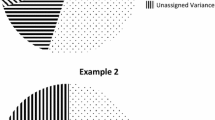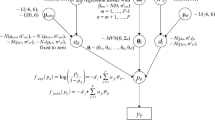Abstract
Mokken scale analysis uses an automated bottom-up stepwise item selection procedure that suffers from two problems. First, when selected during the procedure items satisfy the scaling conditions but they may fail to do so after the scale has been completed. Second, the procedure is approximate and thus may not produce the optimal item partitioning. This study investigates a variation on Mokken’s item selection procedure, which alleviates the first problem, and proposes a genetic algorithm, which alleviates both problems. The genetic algorithm is an approximation to checking all possible partitionings. A simulation study shows that the genetic algorithm leads to better scaling results than the other two procedures.
Similar content being viewed by others
References
BALÀZS, K., HIDEGKUTI, I., and DE BOECK, P. (2006), “Detecting Heterogeneity in Logistic Regression Models”, Applied Psychological Measurement, 30, 322–344.
COHEN, J. (1988), “Statistical Power Analysis for the Behavioral Sciences”, Hillsdale, NJ: Erlbaum.
DE KONING, E., SIJTSMA, K., and HAMERS, J.H.M. (2003), “Construction and Validation of a Test for Inductive Reasoning”, European Journal of Psychological Assessment, 19, 24–39.
EMONS, W.H.M., SIJTSMA, K., and MEIJER, R.R. (2007), “On the Consistency of Individual Classification Using Short Scales”, Psychological Methods, 12, 105–120.
GOUGH, H.G., and HEILBRUN, A.B. (1980), The Adjective Check List Manual, 1980 Edition, Palo Alto, CA: Consulting Psychologists Press.
GRAYSON, D.A. (1988), “Two-Group Classification in Latent Trait Theory: Scores With Monotone Likelihood Ratio”, Psychometrika, 53, 383–392.
HATTIE, J. (1985), “Methodology Review: Assessing Unidimensionality of Tests and Items”, Applied Psychological Measurement, 9, 139–164.
HEMKER, B.T., SIJTSMA, K., and MOLENAAR, I.W. (1995), “Selection of Unidimensional Scales From a Multidimensional Item Bank in the Polytomous Mokken IRT Model”, Applied Psychological Measurement, 19, 337–352.
HEMKER, B.T., SIJTSMA, K., MOLENAAR, I.W., and JUNKER, B.W. (1997), “Stochastic Ordering Using the Latent Trait and the Sum Score in Polytomous IRT Models”, Psychometrika, 62, 331–347.
HOSMER, D.W., and LEMESHOW, S. (1989), Applied Logistic Regression, New York: Wiley.
JUNKER, B.W. (1991), “Essential Independence and Likelihood-Based Ability Estimation for Polytomous Items”, Psychometrika, 56, 255–278.
KROSNIK, J.A. (1991), “Response Strategies for Coping With the Cognitive Demands of Attitude Measures in Surveys”, Applied Cognitive Psychology, 5, 213–236.
MELLENBERGH, G.J. (1996). “Measurement Precision in Test Score and Item Response Models”, Psychological Methods, 1, 293–299.
MICHALEWICZ, Z. (1996), Genetic Algorithms+ Data Structures = Evolution Programs, New York: Springer.
MILLER, A. (2002), Subset Selection in Regression, New York: Chapman and Hall.
MOKKEN, R.J. (1971), A Theory and Procedure of Scale Analysis, The Hague, The Netherlands: Mouton/ Berlin: De Gruyter.
MOKKEN, R.J., and LEWIS, C. (1982), “A Nonparametric Approach to the Analysis of Dichotomous Item Responses”, Applied Psychological Measurement, 6, 417–430.
MOKKEN, R.J., LEWIS, C., and SIJTSMA, K. (1986), “Rejoinder to ‘The Mokken Scale: A Critical Discussion’”, Applied Psychological Measurement, 10, 279–285.
NANDAKUMAR, R., and STOUT, W.F. (1993), “Refinement of Stout’s Procedure for Assessing Latent Trait Dimensionality”, Journal of Educational Statistics, 18, 41–68.
ROUSSOS, L.A., STOUT, W.F., and MARDEN, J.I. (1998), “Using New Proximity Measures with Hierarchical Cluster Analysis to Detect Multidimensionality”, Journal of Educational Measurement, 35, 1–30.
SAMEJIMA, F. (1969), “Estimation of Latent Trait Ability Using a Response Pattern of Graded Scores”, Psychometrika Monograph, No. 17.
SIJTSMA, K., and MEIJER, R.R. (2007), “Nonparametric Item Response Theory and Related Topics”, in Handbook of Statistics, Vol. 26: Psychometrics, eds. C.R. Rao, and S. Sinharay, Amsterdam: Elsevier/North Holland, pp. 719–746.
SIJTSMA, K., and MOLENAAR, I.W. (2002), Introduction to Nonparametric Item Response Theory, Thousand Oaks, CA: Sage.
STRAAT, J.H., VAN DER ARK, L.A., and SIJTSMA, K. (2012), “Using Conditional Association to Identify Locally Independent Item Sets”, Manuscript submitted for publication.
TABACHNICK, B.G., and FIDELL, L. S. (2007), Using Multivariate Statistics, Needham Heights, MA: Allyn and Bacon, Inc.
TATE, R. (2003), “A Comparison of Selected Empirical Methods for Assessing the Structure of Responses to Test Items”, Applied Psychological Measurement, 27, 159–203.
THISSEN, D. and WAINER, H. (1982), “Some Standard Errors in Item Response Theory”, Psychometrika, 47, 397–412.
VAN ABSWOUDE, A.A.H., VAN DER ARK, L.A., and SIJTSMA, K. (2004), “A Comparative Study of Test Data Dimensionality Assessment Procedures Under Nonparametric IRT Models”, Applied Psychological Measurement, 28, 3–24.
VAN ABSWOUDE, A.A.H., VERMUNT, J.K., and HEMKER, B.T. (2007), “Assessing Dimensionality by Maximizing H Coefficient-Based Objective Functions”, Applied Psychological Measurement, 31, 308–330.
VAN DER ARK, L.A. (2005), “Stochastic Ordering of the Latent Trait by the Sum Score Under Various Polytomous IRT Models”, Psychometrika, 70, 283–304.
VAN DER ARK, L.A. (2007), “Mokken Scale Analysis in R”, Journal of Statistical Software, 20(11), 1–19.
VAN DER ARK, L.A., and SIJTSMA, K. (2005), “The Effect of Missing Data Imputation on Mokken Scale Analysis”, in New Developments in Categorical Data Analysis for the Social and Behavioral Sciences, eds. L.A. Van der Ark, M.A. Croon, and K. Sijtsma, Mahwah, NJ: Lawrence Erlbaum, pp. 147–166.
VAN DER ARK, L.A., and BERGSMA, W.P. (2010), “A Note on Stochastic Ordering of the Latent Trait Using the Sum of Polytomous Item Scores”, Psychometrika, 75, 272–279.
VAN DER ARK, L.A., CROON, M.A., and SIJTSMA, K. (2008), “Mokken Scale Analysis for Dichotomous Items Using Marginal Models”, Psychometrika, 73, 183–208.
ZHANG, J. (2007), “Conditional Covariance Theory and DETECT for Polytomous Items”, Psychometrika, 72, 69–91.
ZHANG, J., and STOUT, W.F. (1999), “The Theoretical DETECT Index of Dimensionality and its Application to Approximate Simple Structure”, Psychometrika, 64, 213–249.
Author information
Authors and Affiliations
Corresponding author
Rights and permissions
About this article
Cite this article
Straat, J.H., van der Ark, L.A. & Sijtsma, K. Comparing Optimization Algorithms for Item Selection in Mokken Scale Analysis. J Classif 30, 75–99 (2013). https://doi.org/10.1007/s00357-013-9122-y
Published:
Issue Date:
DOI: https://doi.org/10.1007/s00357-013-9122-y




